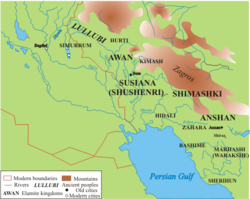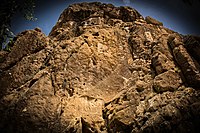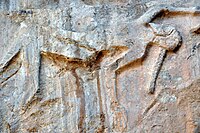Lullubi
Lullubi Kingdom 𒇻𒇻𒉈𒆠 | |
|---|---|
| 3100 BC–675 BC | |
 Territory of the Lullubi in the Mesopotamia area. | |
| Common languages | Unclassified (Lullubian?) Akkadian (inscriptions) |
| Religion | Mesopotamian religions |
| Government | Monarchy |
| Historical era | Antiquity |
• Established | 3100 BC |
• Disestablished | 675 BC |
| Today part of | Iraq Iran |
Lullubi, Lulubi (
The language of the Lullubi is regarded as an
Historical references
Legends
The early Sumerian legend "Lugalbanda and the Anzud Bird", set in the reign of Enmerkar of Uruk, alludes to the "mountains of Lulubi" as being where the character of Lugalbanda encounters the gigantic Anzû bird while searching for the rest of Enmerkar's army en route to siege Aratta.
Akkadian empire and Gutian dynasty

Lullubum appears in historical times as one of the lands
"Naram-Sin the powerful . . . . Sidur and Sutuni, princes of the Lulubi, gathered together and they made war against me."
— Akkadian inscription on the Victory Stele of Naram-Sin.[8]
After the Akkadian Empire fell to the
Ka-Nisba, king of Simurrum, instigated the people of Simurrum and Lullubi to revolt. Amnili, general of [the enemy Lullubi]... made the land [rebel]... Erridu-pizir, the mighty, king of Gutium and of the four quarters hastened [to confront] him... In a single day he captured the pass of Urbillum at Mount Mummum. Further, he captured Nirishuha.
— Inscription R2:226-7 of Erridupizir.[9]
Neo-Sumerian Empire

Following the Gutian period, the

Another famous
Babylonian and Assyrian interactions
In the following (second) millennium BC, the term "Lullubi" or "Lullu" seems to have become a generic Babylonian/
They were said to have had 19 walled cities in their land, as well as a large supply of horses, cattle, metals, textiles and wine, which were carried off by Ashur-nasir-pal. Local chiefs or governors of the Zamua region continued to be mentioned down to the end of Esarhaddon's reign (669 BC).
Representations
In depictions of them, the Lullubi are represented as warlike mountain people.[12] The Lullubi are often shown bare-chested and wearing animal skins. They have short beards, their hair is long and worn in a thick braid, as can be seen on the Victory Stele of Naram-Sin.[11]
Rulers
Rulers of the Lullubi kingdom:[13][14]
- Immashkush (c. 2400 BC)[15]
- Anubanini (c. 2350 BC) he ordered to make an inscription on the rock near Sar-e Pol-e Zahab.[16]
- Awan)
- Irib (c. 2037 BC)
- Darianam (c. 2000 BC)
- Ikki (precise dates unknown)[16]
- Tar ... duni (precise dates unknown) son of Ikki. His inscription is found not far from the inscription of Anubanini.[16]
- Nur-Adad (c. 881 – 880 BC)
- Zabini (c. 881 BC)
- Hubaia (c. 830 BC) vassal of Assyrians
- Dada (c. 715 BC)
- Larkutla (c. 675 BC)
Lullubi rock reliefs
Various Lullubian reliefs can be seen in the area of
Anubanini rock relief
-
The relief is located on the top of a cliff towering over the village of Sarpol-e Zahab. A second relief (Parthian Empire period) appears below.
-
GoddessIshtar.[17]
-
Prisoners of the Lullubis (detail).[17]
-
Prisoners of the Lullubis and their king (detail).[17]
-
Prisoner king (detail). He appears to be wearing a crown.[17]
-
Anubanini rock relief Akkadian inscription.[17]
Other Lullubi reliefs
-
Sar-e Pol-e Zahab, relief III. Beardless warrior trampling a foe, facing a goddess.[19]
-
Sar-e Pol-e Zahab, relief IV. Beardless warrior trampling a foe, facing a goddess.[19]
-
Detail, a dead or dying Lullubian warrior. Darband-i Gawr rock-relief, Mt. Qaradagh, Sulaymaniyah, Iraq, 2200-2000 BCE
-
Detail, a dead or dying Lullubian warrior, Darband-i Gawr rock-relief, Mt. Qaradagh, Sulaymaniyah, Iraq, 2200-2000 BCE
See also
 | |
| History of Greater Iran | |
|---|---|
| 1407–1468 | |
| Aq Qoyunlu Turcomans | 1378–1508 |
| Safavid Empire | 1501–1722 |
| Mughal Empire | 1526–1857 |
| Hotak dynasty | 1722–1729 |
| Afsharid Iran | 1736–1750 |
| Zand dynasty | 1750–1794 |
| Durrani Empire | 1794–1826 |
| Qajar Iran | 1794–1925 |
- Anobanini rock relief
- Zamua
- Tell Kunara
References
- ISBN 978-87-7304-227-4.
- ISBN 978-1-5128-1881-9.
- ISBN 978-1-317-61091-5.
- ISBN 978-0-19-933079-9.
- ISBN 9781134520626.
- ^ "The Languages of the Ancient Near East (in A Companion to the Ancient Near East, 2nd ed., 2007)".
- ^ Tischler 1977–2001: vol. 5/6: 70–71. On the Lullubeans in general, see Klengel 1987–1990; Eidem 1992: 50–4.
- ^ Babylonian & Oriental Record. 1895. p. 27.
- ISBN 9781134520626.
- ^ "Louvre Museum Official Website". cartelen.louvre.fr.
- ^ ISBN 9781890951849.
- ISBN 9780521086912.
- ^ Qashqai, 2011.
- ^ Legrain, 1922; Cameron, 1936; D’yakonov, 1956; The Cambridge History of Iran; Hinz, 1972; The Cambridge Ancient History; Majidzadeh, 1991; Majidzadeh, 1997.
- ^ Cameron, George G. (1936). History of Early Iran (PDF). The University of Chicago Press. p. 35.
- ^ a b c Cameron, George G. (1936). History of Early Iran (PDF). The University of Chicago Press. p. 41.
- ^ ISBN 9781438453255.
- ^ Vanden Berghe, Louis. Relief Sculptures de Iran Ancien. pp. 19–21.
- ^ ISBN 9781438453255.
- ISBN 9781438453255.
- ISBN 9780802058737.
Sources
- Sar-e Pol-e Zahab
- Lullubi
- Qashqai, Hamidreza, Chronicle of early Iran history, Tehran, Avegan press, 2011 (in Persian: گاهنمای سپیده دم تاریخ در ایران )
- Cameron, George, "History of Early Iran", Chicago, 1936 (repr., Chicago, 1969; tr. E.-J. Levin, L’histoire de l’Iran antique, Paris, 1937; tr. H. Anusheh, ایران در سپیده دم تاریخ, Tehran, 1993)
- D’yakonov, I. M., "Istoriya Midii ot drevenĭshikh vremen do kontsa IV beka de e.E" (The history of Media from ancient times to the end of the 4th century BCE), Moscow and Leningrad, 1956; tr. Karim Kešāvarz as Tāriḵ-e Mād, Tehran, 1966.
- The Cambridge History of Iran
- Hinz, W., "The Lost World of Elam", London, 1972 (tr. F. Firuznia, دنیای گمشده ایلام, Tehran, 1992)
- The Cambridge Ancient History
- Majidzadeh, Yusef, "History and civilization of Elam", Tehran, Iran University Press, 1991.
- Majidzadeh, Yusef, "History and civilization of Mesopotamia", Tehran, Iran University Press, 1997, vol.1.
- Legrain, Leon, "Historical Fragments", Philadelphia, The University of Pennsylvania Museum Publications of the Babylonian Section, vol. XIII, 1922.
- Vallat, Francois. Elam: The History of Elam. Encyclopaedia Iranica, vol. VIII pp. 301-313. London/New York, 1998.



![Anubanini rock relief at Sarpol-e Zahab, also called Sarpol-e Zahab II.[19]](http://upload.wikimedia.org/wikipedia/commons/thumb/4/4d/Anubanini_Rock_Relief_1.jpg/200px-Anubanini_Rock_Relief_1.jpg)
![King Anubanini.[17]](http://upload.wikimedia.org/wikipedia/commons/thumb/2/27/Anubanini_relief_constituents_King_Anubanini.jpg/166px-Anubanini_relief_constituents_King_Anubanini.jpg)
![Goddess Ishtar.[17]](http://upload.wikimedia.org/wikipedia/commons/thumb/4/4d/Anubanini_relief_constituents_Ishtar.jpg/133px-Anubanini_relief_constituents_Ishtar.jpg)
![Prisoners of the Lullubis (detail).[17]](http://upload.wikimedia.org/wikipedia/commons/thumb/3/32/Anubanini_relief_constituents_prisoners.jpg/200px-Anubanini_relief_constituents_prisoners.jpg)
![Prisoners of the Lullubis and their king (detail).[17]](http://upload.wikimedia.org/wikipedia/commons/thumb/b/bd/Anubanini_relief_constituents_group_of_prisoners_and_king.jpg/200px-Anubanini_relief_constituents_group_of_prisoners_and_king.jpg)
![Prisoner king (detail). He appears to be wearing a crown.[17]](http://upload.wikimedia.org/wikipedia/commons/thumb/7/71/Anubanini_relief_constituents_prisoner_king.jpg/147px-Anubanini_relief_constituents_prisoner_king.jpg)
![Anubanini rock relief Akkadian inscription.[17]](http://upload.wikimedia.org/wikipedia/commons/thumb/0/06/Anubanini_relief_constituents_Akkadian_inscription.jpg/200px-Anubanini_relief_constituents_Akkadian_inscription.jpg)
![Sar-e Pol-e Zahab, relief I. Beardless warrior with axe, trampling a foe. Sundisk above. A name "Zaba(zuna), son of ..." can be read.[20][19] This is possibly the son of Iddin-Sin, a ruler of the Kingdom of Simurrum.[21]](http://upload.wikimedia.org/wikipedia/commons/thumb/0/07/Sar-e_Pol-e_Zahab%2C_relief_IV.jpg/200px-Sar-e_Pol-e_Zahab%2C_relief_IV.jpg)
![Sar-e Pol-e Zahab, relief III. Beardless warrior trampling a foe, facing a goddess.[19]](http://upload.wikimedia.org/wikipedia/commons/thumb/6/63/Sar-e_Pol-e_Zahab%2C_relief_II.jpg/200px-Sar-e_Pol-e_Zahab%2C_relief_II.jpg)
![Sar-e Pol-e Zahab, relief IV. Beardless warrior trampling a foe, facing a goddess.[19]](http://upload.wikimedia.org/wikipedia/commons/thumb/b/bd/Sar-e_Pol-e_Zahab%2C_relief_III.jpg/200px-Sar-e_Pol-e_Zahab%2C_relief_III.jpg)


